FMLA Conditions List: Qualifying Reasons for Leave
Dealing with a family emergency can leave you reeling. What is covered by the ? How do you know if you, or a family member, have a condition that is covered by FMLA? Going over the can help you determine whether you have a condition covered by FMLA--and, of course, if you do qualify, DoNotPay is here to help you submit your FMLA request.
What is FMLA?
FMLA, or the Family Medical Leave Act, dictates that individuals who have, or who have a family member with, a covered condition can take up to 12 weeks off work unpaid over the course of a 12-month period in order to manage that condition. FMLA only applies to specific employers, including those with more than 50 employees, and only employees who have been employed by the company for at least 12 months prior to requesting leave qualify.
Conditions Covered by FMLA
There are several key circumstances under which conditions are covered by FMLA.
1. Serious Health Conditions
Serious health conditions include either those that require overnight hospitalization and treatment following the illness, or those that require ongoing treatment under the care of a healthcare provider. If a family member requires ongoing assistance and treatment for an illness or injury that prevents that family member from engaging in normal activities, including going to work, taking care of self-care tasks, or helping out around the house, it may qualify that family member for the type of assistance that would require the primary caregiver to take time off work.
Serious health conditions may include conditions like:
- Alzheimer's
- Back pain and conditions
- Cancer
- Diabetes
- Severe depression or anxiety
- Treatment for various types of substance abuse
- Emphysema
- Arthritis
- Pregnancy and complications related to pregnancy
- Nervous conditions, including those that prove debilitating for the patient
Conditions that qualify for FMLA may also include severe injuries or surgery that will require temporary assistance and treatment.
2. Chronic Health Conditions
FMLA does recognize chronic health conditions under its umbrella, including "episodic incapacity." For example, it notes that there are several conditions that would result in incapacity if the patient did not receive treatment, including:
- Pregnancy
- Chemotherapy
- Kidney dialysis
3. Adding a Child to the Family
As part of FMLA, you can take time off when adding a child to your family, either through birth or adoption. FMLA time allows new parents an opportunity to bond with their children and adapt to the changes that may come along with adding a new member to the family. FMLA time may also provide new parents an opportunity to deal with any complications that may arise from pregnancy or delivery, or any health challenges the new baby or new addition may have.
State By State FMLA Rules
If you need to look further into whether you qualify for FMLA based on the specific condition you or a family member have, make sure you look into your state's rules.
| California | Ohio | Oklahoma | Hawaii | South Dakota |
| California | New York | New Jersey | New Mexico | |
| Vermont | Montana | Delaware | Alaska | Wyoming |
| Texas | Massachusetts | Rhode Island | Florida | |
| Pennsylvania | Illinois | Kentucky | Ohio | |
| Michigan | Tennessee | New Hampshire | Wisconsin | |
| Georgia | Oregon | Maine | Arizona | |
| North Carolina | Colorado | Hawaii | Indiana | |
| Nevada | Virginia | Idaho | Missouri | |
| Maryland | Minnesota | Nebraska | Utah | |
| Alabama | Arkansas | Mississippi | South Carolina |
How to Apply For FMLA
If you need to apply for FMLA with your employer, you may have to follow several complicated steps to determine whether you qualify and get approval. You may have to:
- Consult your boss
- Dig through your employee handbook
- Put together a letter that establishes your right to FMLA and how long you intend to be off work
- Submit the letter to the appropriate individual within your organization
All of that while you have enough challenges on your plate due to your health condition or that of a loved one.
Let DoNotPay Help With Your FMLA Application
Do you need to apply for FMLA? Let DoNotPay help. Follow these 6 easy steps:
- Tell us which state you work in (if you work in CA, NY, NJ, MA, WA, or DC, your state has a paid family leave program).

- Choose whether you want us to apply to the program for you or contact your employer with your leave request. If you want to apply for the program, we will walk you through the questions on the form and mail the application form for you.

- If you want us to contact your employer, enter your leave details, including the starting date, number of weeks of leave, and how many weeks of paid leave you are requesting (for example, you may take a 12 week leave, but only request 8 weeks of paid leave to make the request reasonable).

- Indicate whether you are the birth parent or not (birth parents have a few additional protections).

- Enter the name of your company and the person to address this request to.

- Select whether you want us to email the request to your employer on your behalf.

Why Use DoNotPay for Your FMLA Needs?
Applying for FMLA shouldn't be complicated. DoNotPay makes it fast, easy, and convenient. Instead of having to fumble for the words, you can feel confident that the issue is handled correctly.
DoNotPay is Your Source for Your FMLA Needs
Do you need to request FMLA? DoNotPay can help. Whether you're in California, Florida, New York, or New Jersey, DoNotPay is here to help. You can file an FMLA claim, access FMLA forms, write an FMLA request letter, and manage your other FMLA-related tasks much more easily.
Get Started with Your FMLA Request Today
Are you ready to learn more about whether your issue is covered by the ? Check out DoNotPay today to learn how we can help you apply.
 By
By